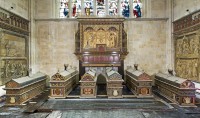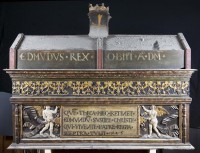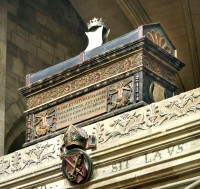 The great Gothic Cathedral of Winchester, in Hampshire, England, is traditionally held to be the final resting place of some of the earliest kings of Wessex and England. The remains of kings and bishops from as early as the 7th century are said to be contained in decorated mortuary chests in the church’s Lady Chapel. The chests are inscribed with names, crowns, shields identifying the remains kept in them, but they were made hundreds of years after the original burials in the Anglo-Saxon Old Minster (the original cathedral on the site of the current one from 660 to 1093) so it’s not certain they were ever accurate. On top of that, the chests were interfered with by Parliamentarians in 1642. When the cathedral authorities put the bones back, they were so jumbled up there was no way to separate out individuals.
The great Gothic Cathedral of Winchester, in Hampshire, England, is traditionally held to be the final resting place of some of the earliest kings of Wessex and England. The remains of kings and bishops from as early as the 7th century are said to be contained in decorated mortuary chests in the church’s Lady Chapel. The chests are inscribed with names, crowns, shields identifying the remains kept in them, but they were made hundreds of years after the original burials in the Anglo-Saxon Old Minster (the original cathedral on the site of the current one from 660 to 1093) so it’s not certain they were ever accurate. On top of that, the chests were interfered with by Parliamentarians in 1642. When the cathedral authorities put the bones back, they were so jumbled up there was no way to separate out individuals.
Over the years the chests have been cleaned and restored, but the human remains and artifacts within have not been examined in forensic detail. As part of a new development program aimed to promote and preserve the Cathedral and to create a better exhibition space in the south transept for the gem of its collection, the 12th century Winchester Bible, the Dean and Chapter of Winchester have commissioned experts to study and document the contents of six of the chests for the first time.
 Because modern technology allows for radiocarbon dating of very small samples, Winchester officials decided to date select bone fragments, something they’ve declined to do until now because it would have required the destruction of a some of the remains entrusted to Winchester’s eternal care. The results from the University of Oxford’s Radiocarbon Accelerator Unit found that the tested bones date to the late Anglo-Saxon and early Norman periods.
Because modern technology allows for radiocarbon dating of very small samples, Winchester officials decided to date select bone fragments, something they’ve declined to do until now because it would have required the destruction of a some of the remains entrusted to Winchester’s eternal care. The results from the University of Oxford’s Radiocarbon Accelerator Unit found that the tested bones date to the late Anglo-Saxon and early Norman periods.
Speaking of this discovery, and the coming project, The Dean of Winchester, The Very Revd James Atwell, has this to say. “This is an exciting moment for the Cathedral when we seem poised to discover that history has indeed safeguarded the mortal remains of some of the early Saxon Kings who became the first monarchs of a united England. Winchester holds the secrets of the birth of the English nation and it does seem that some of those secrets are about to be revealed as future research continues. The presence of the bones in the Cathedral, where they would have been placed near the High Altar and the relics of St Swithun, remind us just how significant the inspiration of the Christian faith was for the foundation of our national life.”
Researchers will also try to separate the jumbled bones to count the number of individuals. Once the remains have been collated, archaeologists hope to be able to determine their age at time of death, sex, stature and physical characteristics of each person. It’s possible that there will be enough circumstantial evidence to be able to loosely match the bones to the royalty and clergy that the chests and the Cathedral’s burial records claim were interred at Winchester. Possible candidates include: Cynegils, King of  Wessex (611–643), Cenwalh, King of Wessex (643–672), Cynewulf, King of Wessex (757-786), Ecbert, King of Wessex (802–839), Ethelwulf, King of Wessex (839–856), Eadred, King of England (946–955), Eadwig, King of England and later Wessex (955–959), Cnut or Canute, King of England (1016–1035), Denmark and Norway, his wife Emma of Normandy (d. 1052) (also queen consort to Ethelred II, King of England), William II ‘Rufus’, King of England (1087–1100), Wini, the first Bishop of Winchester (d. 670), Alfwyn, Bishop of Winchester (d. 1047) and Stigand, Archbishop of Canterbury (d. 1072).
Wessex (611–643), Cenwalh, King of Wessex (643–672), Cynewulf, King of Wessex (757-786), Ecbert, King of Wessex (802–839), Ethelwulf, King of Wessex (839–856), Eadred, King of England (946–955), Eadwig, King of England and later Wessex (955–959), Cnut or Canute, King of England (1016–1035), Denmark and Norway, his wife Emma of Normandy (d. 1052) (also queen consort to Ethelred II, King of England), William II ‘Rufus’, King of England (1087–1100), Wini, the first Bishop of Winchester (d. 670), Alfwyn, Bishop of Winchester (d. 1047) and Stigand, Archbishop of Canterbury (d. 1072).
If any one of these, particularly the early Anglo-Saxon kings, pan out forensically, Winchester Cathedral would be confirmed as the first national mausoleum, akin to the cathedrals of St. Denis and Reims in France.
There’s an intriguing little throw-away line with no follow-up in the press materials.
We have discovered in the chests some unexpected contents which are not mortal remains, and one of the aspects of the next stage of analysis will be to discover why they are there.
Ooh, unmentionable objects of mysterious origin! I’m looking forward to the explanation.
Bring forth the unmentionables!
Unmentionables of mysterious origin? Hm, that reminds me of my childhood when my grand-folks said “unmentionables”. They were referring to underwear, and underwear of mysterious origin sounds like the office receptionist or the mailman has been around a house for a little too long. 🙂 In all seriousness, I wonder what it all is also.
To the author or proof-reader, your text is….”We have discovered in the chests some unexpected contests which are not mortal remains”… I do believe that should read CONTENTS not CONTESTS! That is, unless one of the chests contains all the mysterious and unmentionable materials necessary for a Medieval Joisting match……!
“… objects of mysterious origin!” It’s those little green men again.
Immortal remains??
Taking into account that the building is at least the 2nd one, i.e. at closer inspection maybe the 3rd or fourth, a wild mix of immortal and mortal remains, some of them from the original owners, is pretty much exactly what we should expect.
The 17th century reinterment was also not the 1st one, and some of the ‘relics’ might be elsewhere. Also, there was reason to stow away the remains, for they were, for instance, (not) catholic and then royal. So lets see what revelations there might be.
I wonder how this research will lend to the discussion of non-marital events in royal lives.
Unmentionables and not mortal remains….false teeth and toupees were the first things that came to mind.
Hi, my thought is that they can’t very well tell us that they have found precious jewels down there amongst the bones – as this would cause vandalism. 😆
I hope they are books.
Antique panties. :boogie:
They obviously date from the mid 16th century. Do we know who commissioned them? Style is comparable to that of Bishop Gardiner’s adjacent chantry.
With the astonishing recent advances in DNA and factors that facilitate determination of the place of birth and upbringing of skeletal remains, Cnut, for starters, ought to be easy enough to identify.
Canutes Royal knickers Id’d. How will this affect Kate’s pregency???? OMG I can see the Enquier headlines now. :p
The present mortuary chests are the latest of a series of receptacles for the remains of Saxon monarchs and bishops, and they have a well-documented history. The chests are now back in position on the Presbytery screens to right and left of the high altar. Originally there were ten of them dating from about 1525, four of which survive, and the remaining two are later replacements of the 1660s. The chests previously contained mediaeval painted wooden inner chests whiich, in turn, had contained lead coffers of the mid-12th century. As a boy (nearly 70 years ago) I remember seeing one of the inner chests displayed in a glass case in the Cathedral.